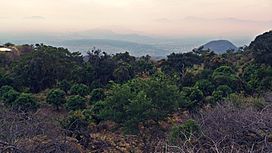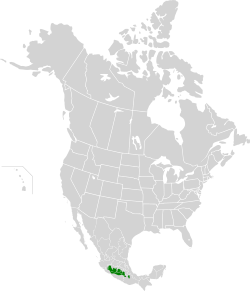Balsas dry forests facts for kids
Quick facts for kids Balsas dry forests |
|
|---|---|

|
|

location of the Balsas dry forests ecoregion
|
|
| Ecology | |
| Realm | Neotropical |
| Biome | tropical and subtropical dry broadleaf forests |
| Borders |
List
|
| Geography | |
| Area | 37,384 km2 (14,434 sq mi) |
| Country | Mexico |
| States | Guerrero, Mexico, Michoacan, Morelos, Oaxaca and Puebla |
| Conservation | |
| Conservation status | Critical/endangered |
| Global 200 | Mexican dry forests |
| Protected | 10.9%% |
The Balsas dry forests are a special type of tropical dry forest. They are found in western and central Mexico. This area is called an ecoregion. An ecoregion is a large area of land or water that has its own unique plants, animals, and climate.
Contents
What are the Balsas Dry Forests?
Where are they located?
These forests are in the Balsas River basin. A basin is like a big bowl-shaped area where all the water flows into one main river. The Balsas dry forests cover about 62,400 square kilometers (24,100 square miles).
The Balsas basin stretches from east to west. It is located between two mountain ranges. To the north is the Trans-Mexican Volcanic Belt. To the south is the Sierra Madre del Sur.
The Balsas dry forests ecoregion spreads across several Mexican states. These include Michoacán, Guerrero, Mexico State, Morelos, Puebla, and Oaxaca.
What's around these forests?
The mountains surrounding the Balsas dry forests have different types of forests. These are mostly pine-oak forests.
- To the north and northwest, you'll find the Trans-Mexican Volcanic Belt pine-oak forests.
- To the south, there are the Sierra Madre del Sur pine-oak forests.
- To the east, you'll see the Sierra Madre de Oaxaca pine-oak forests.
To the northeast, there is a dry, shrubby area called the Tehuacán Valley matorral. The Balsas dry forests also meet the Southern Pacific dry forests near the coast. This happens where the Balsas River cuts through the Sierra Madre del Sur mountains to reach the Pacific Ocean.
Climate of the Balsas Dry Forests
The climate here is tropical and subhumid. This means it's warm all year, but not extremely wet. The area gets less than 120 centimeters (47 inches) of rain each year. Most of this rain falls during a specific season. There is also a long dry season. This dry period can last for up to eight months.
Plants of the Balsas Dry Forests (Flora)
The plant life in these forests is very interesting. You can find different types of plant communities.
- Tropical deciduous forest (also called selva baja caducifolia): In this forest, many trees lose their leaves during the dry season. This helps them save water.
- Thorn forest (bosque espinoso): This forest has many thorny plants.
- Tropical semideciduous forest (selva mediana subcaducifolia): These are found in areas with deeper soil and more moisture, like near rivers. Some trees here lose their leaves, but not all of them.
Common Trees and Plants
Many trees in the Balsas dry forests belong to the Bursera family. Some common ones are Bursera longipes, B. morelensis, and B. odorata. They are often called palo mulato. Another common tree is the fragrant bursera (Bursera fagaroides). You might also see chupandra (Cyrtocarpa procera).
Other well-known trees include:
- Pochote (Ceiba parvifolia)
- Brasiletto or Mexican logwood (Haematoxylum brasiletto)
- Lysiloma microphylla
- Cazahuate (Ipomoea murucoides)
Cacti are also very common here. You can find species like Pachycereus and Cephalocereus. The ground layer usually has few plants. Some grasses found here are sideoats grama (Bouteloua curtipendula) and Rothrock's grama (Bouteloua barbata var. rothrockii).
Unique Plants (Endemic Species)
The Balsas dry forests share many plant species with Mexico's Pacific coastal dry forests. However, many plants here are endemic. This means they are found only in this ecoregion and nowhere else in the world.
For example, about 45% of the plant species in Cañón del Zopilote, Guerrero, are endemic. In Infiernillo, Michoacán, about 30% of the species are found only in the Balsas basin. About half of the 45 types of Bursera trees in this ecoregion are endemic. The area is also home to many different species of Brongniartia, Desmodium, Ipomoea, and Mammillaria.
Animals of the Balsas Dry Forests (Fauna)
This ecoregion is home to many amazing animals.
Mammals
Some of the native mammals you might find here include:
- The powerful jaguar (Pantera onca)
- The sleek jaguarundi (Herpailurus yagouaroundi)
- The spotted ocelot (Leopardus pardalis)
- The social collared peccary (Tayassu tajacu)
- The clever coyote (Canis latrans)
- The grey fox (Urocyon cinereoargentea)
- The curious white-nosed coati (Nasua narica)
Smaller mammals also live here, such as:
- The silky pocket mouse (Perognathus flavus)
- The California myotis (Myotis californicus)
- The long-legged myotis (Myotis volans)
- The western yellow bat (Dasypterus xanthinus)
Important Bird Areas
Parts of the Balsas dry forests are recognized as Important Bird Areas. These are places that are very important for bird conservation. Some of these areas include:
- Sierra de Taxco–Nevado de Toluca
- Cañón del Zopilote
- Valle de Tehuacán–Cuicatlán
- Cañón de Lobos
- Sierra de Huautla
- Papalutla-Tecaballo
Protected Areas
It's very important to protect these unique forests. About 10.9% of the Balsas dry forests ecoregion is in protected areas. This means these lands are set aside to keep nature safe. A study in 2017 found that about 1,451 square kilometers (560 square miles) were protected.
Some of the protected areas include:
- Boquerón de Tonalá Flora and Fauna Protection Area
- Chichinautzin Biological Corridor Flora and Fauna Protection Area
- El Tepozteco National Park
- Grutas de Cacahuamilpa National Park
- Sierra de Huautla Biosphere Reserve
- Sierra de Nanchititla Natural Park
- Tehuacán-Cuicatlán Biosphere Reserve
- Zicuirán-Infiernillo Biosphere Reserve
See also

- Bosques secos del Balsas para niños
- List of ecoregions in Mexico

